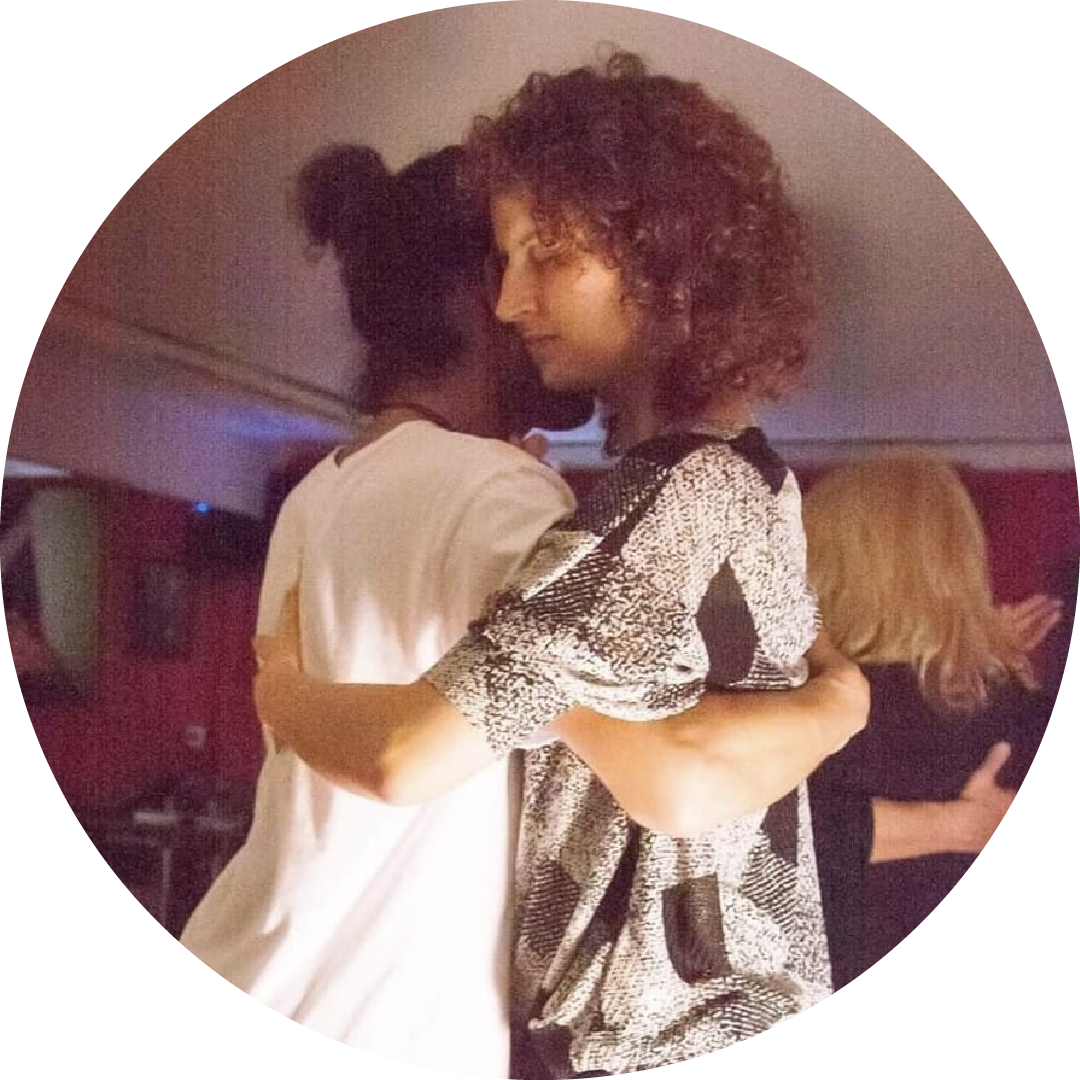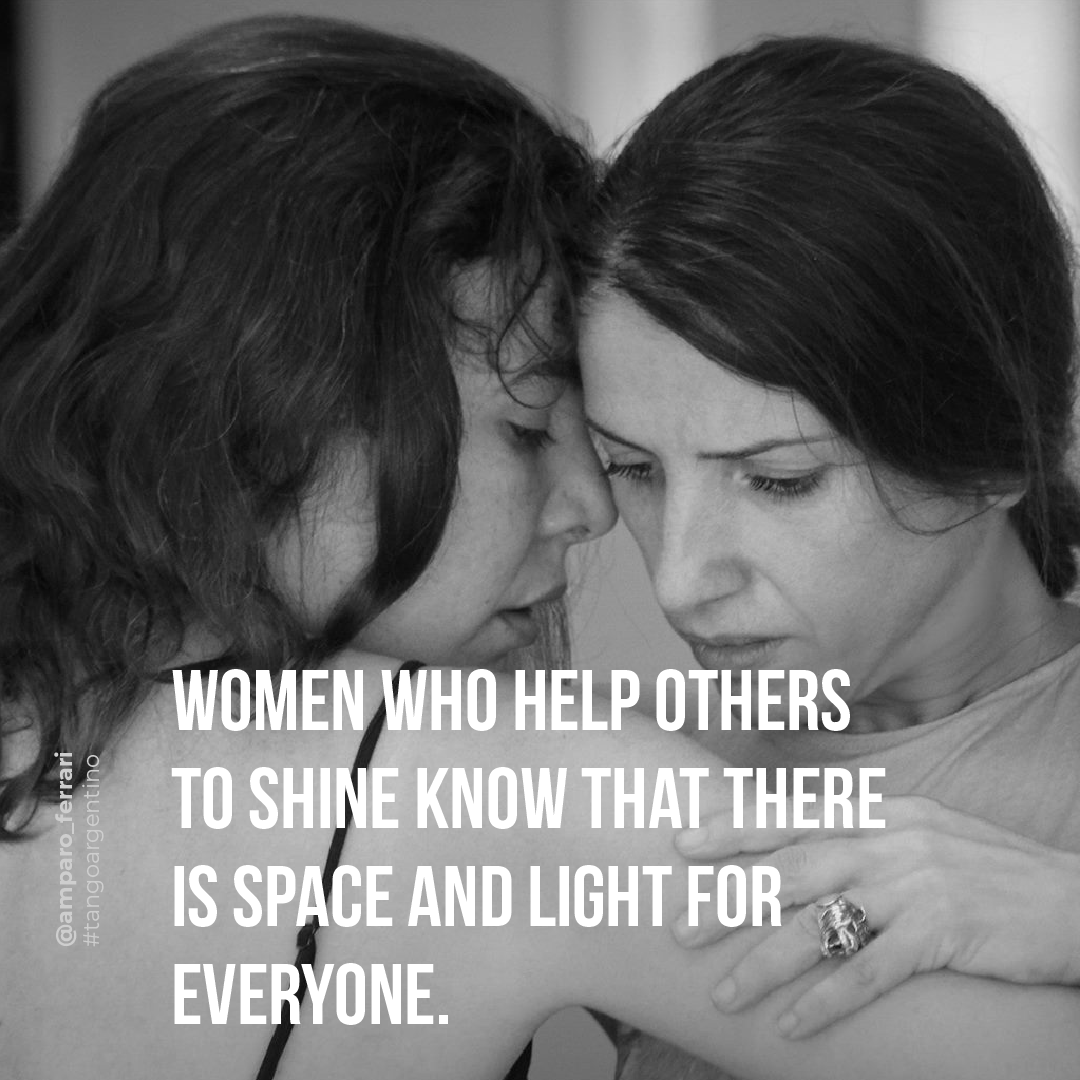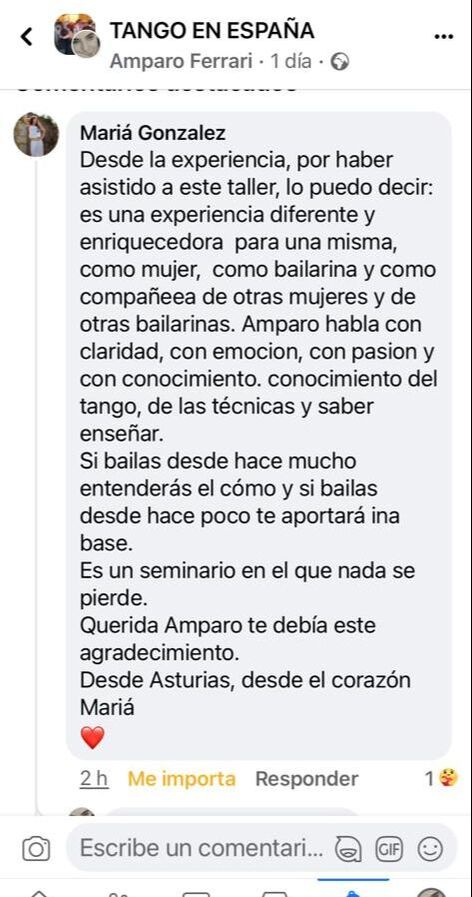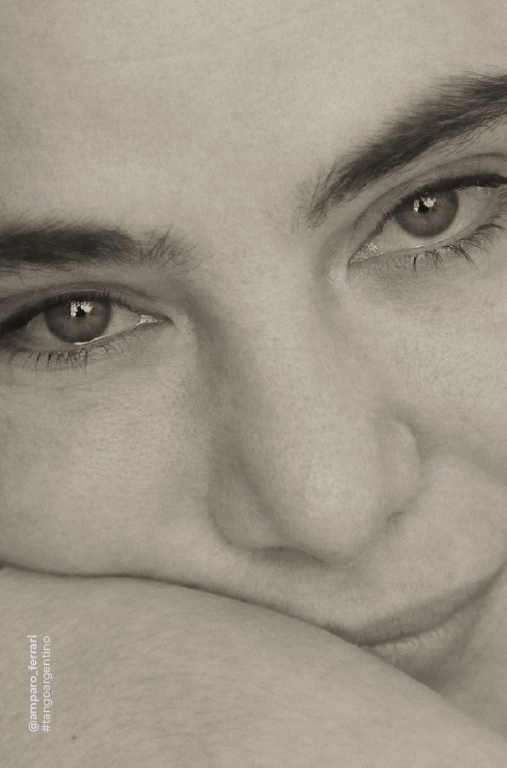Before beginning: I avoid using the term "follower", because I am against identifying the role with that idea. Therefore, "female role". That is beyond the gender with which the person who executes it is identified. A role like an actor. Female to define the prevailing energy
ARE YOU STILL THINKING THAT YOUR PERFORMANCE IS SUBJECT TO YOUR PARTNER'S ABILITY?You spend half the night looking at him, he's the best. You know that dancing with him is going to be pure enjoyment, but the hours go by and he hasn't even noticed you. The milonga is coming to an end, he has danced with everyone except you, and you have been too busy looking at him to accept another invitation. How do you feel when you return home? I don't even need to describe it to you, come on, what a wreck. You keep turning your head around a thousand times. What if instead of waiting for him to look at me, I would have... The real problem is that you are convinced that the only way to enjoy dancing is with someone who leads you well. In the end, if he is not musical, if he is not creative, let's go if he dances badly; you are forced to follow. You know you're going to have a bad time, very bad. But since you are a good follower, you will follow. So of course, it's better to go home frustrated and without dancing, than have danced like shit. And then, of course, how do you not spend all night looking for him? Yea, the good one. |
|
What if I told you that enjoying dancing is not necessarily conditioned by the ability of your partner? There is something that nobody dares to tell you about the female role in Tango, and that is that she does not always have to follow, that she can and SHOULD contribute. A good dancer makes a 7 out of a 4 dancer, and a 10 out of a 7. And she enjoys, enjoys with everyone because she owns her dance. She knows how to adapt to each situation, find the spaces for her expression in any circumstance, and how to enhance the dance of her partner. |
REACH YOUR EXPRESSIVE FREEDOM AND REVOLUTIONIZE YOUR WAY OF PERCEIVING YOUR ROLE
|
Let's start by demolishing the most widespread myth about the Tango dance. Everyone talks about the conversation in Tango, but then they teach to monologue. They have told you, and you have believed it: The woman has the role to follow. The couple bond understands in this way recognizes a linear and unidirectional communication model. That favors speaking over listening, discarding the idea of feedback. The masculine role acts from its own vision and claims that the female role only obeys. Women are removed from all responsibility, their autonomy is denied, and their initiatives are annulled. In this way, also the person is annulled. |
But the Tango in its origins was not danced like that. It is impossible to think that this dance was created with this model. It is also enough to look carefully at the performances of dancers like Alejandra Mantinian, Noelia Hurtado and Gloria Dinzel to ask yourself some questions. This model, in fact, implies dancing with figures and set phrases. The man who dances with a "good follower" will hardly leave his comfort zone. He will probably dance with the forms and figures that he knows and masters. It is an active female role that invites the man to explore the unknown. This getting out of our comfort zone is what opens the possibility for improvisation to appear. And let me remind you: the only truth in this dance is improvisation. |
|
Improvisation, therefore, is possible, only on the basis of parity of roles. Both in the expressive possibilities and in the assumption of the responsibilities of the couple. Responsibility in relation to the composition of the dance discourse, the management of space, and the relationship with music.
Improvisation appears when the movement is the conjunction of both wills. |
YOU ARE RESPONSIBLE FOR YOUR ENJOYMENT
|
The seminar's main objective is for you to assume responsibility for your role, your performance, and your enjoyment. And so, you can build dance couples mature, equal, and capable of improvising. And as in life, also in dance, to create mature relationships we need to work on our autonomy, security, and self-esteem. We are going to face this empowerment work from our bodies. If I modify my way of being bodily, I modify my feeling. Let's self-observe without judgment those changes. And we are going to question everything we thought up until now, to open ourselves to a paradigm shift. |
In this seminar:
|
|
If I tell you this, it is because I have experienced it. I have been dancing in a submission role the whole of my life. Getting out of the milonga frustrated, for not being able to dance to my full potential. Feeling like I wasn't in control of my destiny. Of suffering in some way the dance instead of being an active creator. Whether positive or negative, the experience was not up to me. I found myself staring desperately at the most skilled man. And that made me feel insecure and needed. I, who had always considered myself an independent woman.
I also used to dance with fear and questioned if I was a good follower. Furthermore, I used to feel that I can't find a place to express myself. I felt insecure and saw my role as inferior. The creation of the dance completely depended on the man. And then I met him, my guru. Rodolfo Dinzel. Cacho, my beloved Cacho. And I received the biggest lesson that anyone had given me up to that moment. "You dance very beautifully, but you are very much at the service of the man. I want to see you". Phrase that he repeated to me several times, “I want to see you”, “I want to see you”... “I want to see you”. Added to others like “You are very obedient”, "Everything is very nice, but you, don't you have anything to say? I want to see you." At the time, I had no idea how to do it, but I also wanted him to see me. |
|
This seminar is the outcome of more than a decade of study and research on the active female role in Argentine Tango.
It takes the Dinzel System as a pedagogical foundation and integrates the perspectives of other great teachers with whom I had the privilege of studying like Olga Besio, Alejandra Mantinan, and Noelia Hurtado. Furthermore, my personal experience, my own transformation from a submissive role to a friendly, serene, and consolidated active role. |
When I evaluate my professional experience in the pedagogical field, I consider that the most significant achievement was having been invited to teach at my master's studio, Los Dinzel, in Buenos Aires.
Tango has guided me in a process of endless self-knowledge and personal growth. That is why my purpose today is to help those who are in the process of learning this dance so that we all learn from the popular wisdom of this genre a more humane, loving, and conscious way of living.
Tango has guided me in a process of endless self-knowledge and personal growth. That is why my purpose today is to help those who are in the process of learning this dance so that we all learn from the popular wisdom of this genre a more humane, loving, and conscious way of living.
THESE ARE THE 4 MODULES THAT MAKE UP THE SEMINAR
Each module lasts 2.30 hours, for a total of 10 hours of intensive work.
BODY
|
MusicalityWe start from an intuitive approach that recognizes the downbeat as simple lines of the notebook in which to write our musical interpretation. Music proposes different stimuli, recognizing and interpreting them is key to musically justifying our initiative. A musically justified initiative has a better chance of being heard and accepted. Well, it's not you alone who's talking anymore. They are two voices speaking in unison. Then we will distinguish the technical differences to interpret the rhythmic and the melodic. |
ExpressionWe will explore tools and techniques to develop expression skills in the Tango language. We will ask ourselves questions about emotions. Likewise, we will verify how emotion alters the quality of movement. And finally, we will think about how to efficiently manage the emotions that fight to get out. |
PROPOSAL FROM
|
|
You will also receive a reflection notebook that will accompany you during the seminar. In it, you can, through powerful questions, write down your thoughts. It will also help you notice how your way of thinking and perceiving yourself changes throughout the experience. I have included this notebook because I am convinced that the exercise of writing develops critical thinking and self-knowledge, essential to face, after the seminar, contexts in which the active female role is questioned. |
YOU WILL BE WONDERING IF YOU ARE GOING TO FIND RESISTANCE TO THIS WAY OF DANCE IN THE MILONGA
|
Let's go by parts. First, let me clarify that this proposal is not modern or new. We are always within the aesthetic limits of traditional Tango dance. I had the confirmation, dancing in the Salón Canning with a man of about 80 years old. When we finish the first tango, he tells me: “Waw, how nice! It's like dancing with my wife again. The girls these days are waiting for me to do everything, and I get tired. I'm old, you see?" |
ARE YOU GOING TO FIND RESISTANCE FROM MEN
WHO DO NOT KNOW THIS kind of LANGUAGE?
|
Yes, and it's normal. Leaving the comfort zone can be very challenging for some. They might even get defensive. Get scared. Even attack you. Especially at the beginning, when you still haven't mastered this use of language. But remember, the responsibility of the female role is to take the man out of his learned and routine steps, to open the doors to the unknown, so that improvisation can be born. In this seminar, I am going to give you the keys so that your proposal is accepted as natural, without forcing it. But I can't lie to you, this is just the beginning. |
|
When a woman decides to leave her comfort zone, to change from a passive and submissive role to an active one with her own voice, she will make many mistakes. Mistakes are part of every learning process. To know what, how, and when to propose you will have to do thousands of tests, trials, and attempts. In this initial phase, your dance is likely to cause some discomfort. Everything is new for you, again, like when you were a beginner. Manage the dance floor, issue communication codes, and interpret the music. Just following is undoubtedly much easier. |
|
But, if you are reading this, you know within yourself that this "just follow" is small for you. Trust the process, be patient with yourself, and keep trying and making mistakes. There will come a day when his reaction, his surprise at your unexpected proposal, is a deep respect and listening. |
WHAT I CAN PROMISE YOU IS THAT AS SOON AS YOU FINISH THE SEMINAR, YOU WILL ALSO BE SAYING THINGS LIKE THIS:
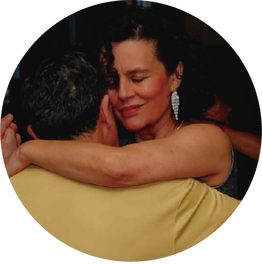
"A Course in Miracles:
Over the weekend, I have participated in a women's technique workshop with Amparo.
How is it possible to initiate such a profound transformation in such a short time? I know that all the women who attended and me were emotional and, in a certain way, we were not the same when we said goodbye.
The teacher, who manages to change the vision of the student through what he teaches and how she teaches it, contributes to his evolution. The teacher who also does it through what she "is" starts a revolution.
With each word, each silence, each wait, each movement… Amparo transmits an elegantly simple and complex web of knowledge that reveals a long history of study, research, passion and purpose.
Tango unfolds as the vibrant, vital learning path that it is for those who start it, honoring tradition and the search for individual expression in communication with others.
Profound teachings are derived from everything she does. When she says, for example: “I'm going to show you something. Let's see if I get it”, you experience an amazing lesson in dealing with vulnerability and honesty. That "let's see if it comes out" in the mouth of someone like her, said as she says it, is admirably therapeutic and exemplary for dance and life.
I feel more accompanied and braver. I respect myself more. Furthermore, I forgive myself more.
I can only invite everyone to discover for themselves as much as she offers to help you grow and enjoy. Thank you, Amparo, for sharing with so much love what you are conquering."
Maria Alvarez, Asturias. April 2023
Over the weekend, I have participated in a women's technique workshop with Amparo.
How is it possible to initiate such a profound transformation in such a short time? I know that all the women who attended and me were emotional and, in a certain way, we were not the same when we said goodbye.
The teacher, who manages to change the vision of the student through what he teaches and how she teaches it, contributes to his evolution. The teacher who also does it through what she "is" starts a revolution.
With each word, each silence, each wait, each movement… Amparo transmits an elegantly simple and complex web of knowledge that reveals a long history of study, research, passion and purpose.
Tango unfolds as the vibrant, vital learning path that it is for those who start it, honoring tradition and the search for individual expression in communication with others.
Profound teachings are derived from everything she does. When she says, for example: “I'm going to show you something. Let's see if I get it”, you experience an amazing lesson in dealing with vulnerability and honesty. That "let's see if it comes out" in the mouth of someone like her, said as she says it, is admirably therapeutic and exemplary for dance and life.
I feel more accompanied and braver. I respect myself more. Furthermore, I forgive myself more.
I can only invite everyone to discover for themselves as much as she offers to help you grow and enjoy. Thank you, Amparo, for sharing with so much love what you are conquering."
Maria Alvarez, Asturias. April 2023
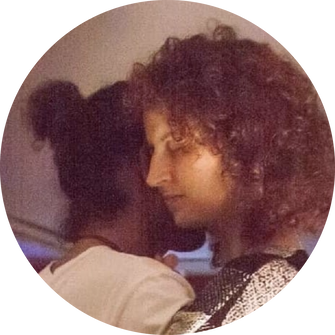
I have a lot to thank Amparo for, but first I would like to explain my situation when I had the opportunity to attend the seminar. I have been dancing tango for more than 12 years. I started when I was 21 years old, I have danced in several milongas around Europe, and it was not until two years ago, that I started flirting with the leader role.
There are two phrases that have marked me deeply. The first, "a good dancer dances well, regardless of who her partner is, for this knowledge and technique are necessary." With Amparo I discovered another twist on this phrase: "A good dancer can improve the dance of her partner regardless his level"
I have been fortunate to have had very empowered teachers, owners of her dance, but none of them has been able to convey to me everything necessary to make me the owner of mine like Amparo. Now the pieces begin to fit together.
There can be many opinions about what is the role of women in tango. In my first years, I have met leaders who complain when the follower does not do what they propose, but now I have also met leaders who applaud the interpretation of the followers and love that they have an active role. When I play the role of leader, I love to be surprise, that they interpret the music, I love to listen actively to my partner and give them space to express themselves.
The workshop that Amparo offers is a safe place where I was able to express my concerns. Surprisingly, a beautiful sorority was generated among the attendees, and now we are more aware that we are not alone, that we are there if we need each other, that we can talk about our concerns, and find support.
The second phrase that marked me when I started dancing tango was told to me by a good friend: "Tango is very ungrateful to older women. Take advantage now that you are young." In all the milongas I have always seen more women than men sitting down waiting for their opportunity. Thanks to Amparo I have seen that this reality can change. It is a fact. We were able to verify it live at the end of the workshop.
Dear friend, I am free, Amparo's workshop has allowed me to wake up. I feel responsible for my dance and my situation, and my voice can be heard by anyone who wants to appreciate it.
Laura, (Burgalesa en Gijón) 2023.
There are two phrases that have marked me deeply. The first, "a good dancer dances well, regardless of who her partner is, for this knowledge and technique are necessary." With Amparo I discovered another twist on this phrase: "A good dancer can improve the dance of her partner regardless his level"
I have been fortunate to have had very empowered teachers, owners of her dance, but none of them has been able to convey to me everything necessary to make me the owner of mine like Amparo. Now the pieces begin to fit together.
There can be many opinions about what is the role of women in tango. In my first years, I have met leaders who complain when the follower does not do what they propose, but now I have also met leaders who applaud the interpretation of the followers and love that they have an active role. When I play the role of leader, I love to be surprise, that they interpret the music, I love to listen actively to my partner and give them space to express themselves.
The workshop that Amparo offers is a safe place where I was able to express my concerns. Surprisingly, a beautiful sorority was generated among the attendees, and now we are more aware that we are not alone, that we are there if we need each other, that we can talk about our concerns, and find support.
The second phrase that marked me when I started dancing tango was told to me by a good friend: "Tango is very ungrateful to older women. Take advantage now that you are young." In all the milongas I have always seen more women than men sitting down waiting for their opportunity. Thanks to Amparo I have seen that this reality can change. It is a fact. We were able to verify it live at the end of the workshop.
Dear friend, I am free, Amparo's workshop has allowed me to wake up. I feel responsible for my dance and my situation, and my voice can be heard by anyone who wants to appreciate it.
Laura, (Burgalesa en Gijón) 2023.
|
Maria Gonzalez
From my own experience, having attended this workshop, I can say: It is a different and enriching experience for oneself, as a woman, as a dancer and as a good companion to other women and other dancers. Amparo speaks clearly, with emotion, with passion and with knowledge. Knowledge of tango, techniques and knowing how to teach. If you have been dancing for a long time you will understand how, if you have been dancing recently it will provide you with a base. It is a seminar in which nothing is lost. Dear Amparo, I owed you this gratitude. From Asturias, from the heart. Maria |

… "It was an opportunity to discover new opportunities and solutions to dance more consciously and enjoy this wonderful dance more. The experience also helped me understand that it is not correct to place all the responsibility on the leader. In a word: a Challenge!! "
Claudia Favretto
Claudia Favretto
|
"For me, the expression that summarizes the course is "exercised responsibility". In any relationship between two people, both parties are important and add up, but there you have the language: you can negotiate, talk, and reach an agreement (it will cost you more or less depending on the person or the situation, but you know what the tool is). In tango, I did not know how to exercise that responsibility; it seemed that the only option was to simply follow, and that leaves you in a position of inferiority/submission/dependence; just like an object. It is something that sometimes takes me out of the relationship, and therefore, out of the dance. With the course, I have learned ways to exercise that responsibility through a language that I was not aware of. With some dancers or at times I can go in silence because I don't need to say anything, but with others, I don't, and now I have the tool that allows me to be able to relate in another way and be responsible for the dance of the two."
|
FREQUENT QUESTIONS
- Who is it for?
|
This seminar is originally intended for women only. In such a way that feminine energy flows without conditioning.
But if you belong to the queer community and identify with this role, you are welcome. |
- What do I have to bring?
|
A desire to challenge your beliefs, an open mind and a body eager to explore.
Also, bring:
|
- Can I participate in only one module?
|
Yes, with the premise that you will only get a partial vision of the change that I propose for your dance.
|
|
I want this way of living Tango to be accessible to as many women as possible. That the number of women who walk this path of transformation toward their own expressive freedom in Tango dance increases drastically.
This process implies an internal empowerment work, which favors the development of a society in which men and women can share from parity, complicity, and reciprocal support. Also, it is time that women stop looking at each other as enemies and recognize that sisterhood between women strengthens us and helps us shine. And, I'm here for that, my goal is for you to shine to your full potential. In short, the true purpose of the seminar goes far beyond the Tango dance and is to bring light, gratitude, and feminine love to the world. That's why I'm excited, that you join this revolution. |
TAKE THE FIRST STEP TOWARDS YOUR EXPRESSIVE FREEDOM BY booking YOUR PLACE
At the moment, the seminar is scheduled for the following days and cities:
Ediciones pasadas:
|
|
|
|
|
I rely on ASD Tango Venice Dinzel International, as a legal basis for the processing of your data. You have the right of access, rectification, deletion, limitation, opposition to treatment and portability. You can exercise your rights at [email protected]. More information in the privacy policy
If you have any questions about the seminar, contact me: [email protected]


